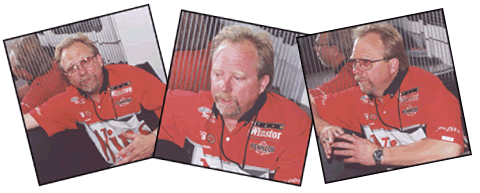|
|
 |
|
||||||
|
|
||||||||
|
What's your opinion of the chassis problems that have been seen of late? In particular, we're talking about the incidents that Tony Schumacher and Larry Dixon Jr. experienced at Memphis. The conditions at Memphis and before that this year at Englishtown were extreme and the parts we have were not designed to deal with them. I don't think you can say we have a chassis problem per se. Yes, there is a problem, but remember when everyone thought there was a tire problem? Again, there was a problem that involved the tires, the tread was separating from the carcass, but I think bigger questions determine these problems. Such as? Like with drag. The wing drag that develops at three-quarter track from running in conditions like we saw in Memphis is not like anything we've seen before. We were running at roughly an adjusted altitude of 800 feet below sea level at Memphis, so the drag is a lot different. At 1,000 feet we're going 300-mph and into a cold headwind. There's no comparison to what we'd been doing in the recent past with conditions like these. This really hurts the tires. With 90-percent, you're actually working the tires harder because under the 100 percent conditions, the tires spun harder. They didn't hook up as well. The heat and spin dissipated the potential to cause the tires to separate. Now all that down-force really plants the tires, and it plants them hard. With the chassis, things take place a little differently. There is a tremendous load on the chassis when the car is planted like it is now on 90-percent. The down-force is tremendous on the cars at 90-percent, and it's my opinion that we need to take some out of it. We do that by taking down force out of the wing. We got a 100-percent up on a 90-percent car. In my mind, the problem is not the chassis, it's the rear wing. If I had to say what I think will cure both problems, we need to change the chassis design, take some load off of it, and we need to take some down-force out of the wing. Aerodynamics are causing the tire and chassis problems now. A couple of fan-oriented questions now. What's it like overseeing a Top Fueler and a Funny Car (Bruce Sarver's eMoola.com entry)? Is it like running two separate types of cars, two different worlds? No. Our engines are almost exactly the same, except we don't run the Funny Car engine quite as hard. We use a little less compression for example. However, it's the same blower overdrive, cam, etc. The way I see it is if one car, say the fueler, makes a ton of power then so will the Funny Car. As far as the Funny Car having a body and not the Top Fueler, the body only affects the engine in that it doesn't need as much fuel at certain points of the track. At other parts, it does. An out-of-the-blue query: who do you think the best fuel mechanic in the sport is, leaving yourself out of the running, of course? Austin Coil (John Force Funny Car crew chief). I'd say he's obviously at the top of the list. First and foremost, he's an excellent racer; he races you. When you pull up alongside him, your car is the one he plans on beating and he gives it his best, which has been pretty good lately. His crew works together flawlessly, he's won…10 NHRA Winston titles, he's a great innovator, and he has a budget. That's hard to deal with. |
|
|||||||
|
Copyright 1999-2001, Drag Racing Online and Racing Net Source |
||||||||



 Car
and Driver
Car
and Driver Car
Craft
Car
Craft Automobile
Automobile